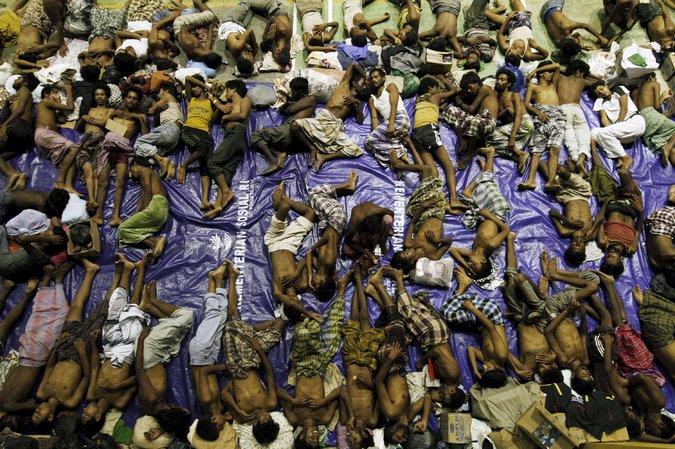More than 1,000 refugees, including many women and children, came ashore in Malaysia early on Monday in what appears to be a sign of an accelerated exodus from western Myanmar and Bangladesh.
The landing of 1,051 people near a hotel beach on the Malaysian resort island of Langkawi on Monday came after 582 arrived Sunday on the Indonesian island of Sumatra.
The Malaysian and Indonesian authorities say the refugees are a mix of Bangladeshis and ethnic Rohingya, a persecuted and stateless Muslim ethnic minority that inhabits western Myanmar and eastern Bangladesh.
The group that came ashore on Langkawi looked “very bad,” said Harrith Kam Abdullah, the most senior police officer on the island. He said the refugees would be sent to the Malaysian mainland.
“They landed on a tourist beach,” Mr. Harrith said in a telephone interview. The group included 101 women and 52 children, he said.
Peter Athan, the general manager of the Four Points by Sheraton in Langkawi, said hotels on the island had organized to send food and water for the refugees.

The Office of the United Nations High Commissioner for Refugees said in a report released Friday that an estimated 25,000 people fled Myanmar and Bangladesh by boat in the first quarter of this year, twice the number of last year.
The exodus has been spurred by the persecution of the Rohingya, who number around one million in Myanmar alone. The government of Myanmar rejects them as citizens, restricts their travel within the country and refuses to call them Rohingya, preferring the term Bengali, which implies that they belong across the border in Bangladesh. Bangladesh also rejects the Rohingya as citizens and has its own refugee camps, both official and unofficial, filled with more than 200,000 Rohingya.
Attacks on Rohingya villages in 2012 and 2013 by Buddhist mobs in Myanmar forced more than 100,000 Rohingya into refugee camps, where most remain. The violence has abated, but anti-Muslim sentiment remains potent in Myanmar and is linked to a large political movement known as 969 that portrays Muslims as a threat to Buddhism.
The Rohingya pay smugglers to take them to Malaysia, which in recent years has turned a blind eye to their clandestine immigration.
“This is a ruthless business where smugglers will let them die to set an example for others,” said Jeffrey Labovitz, the head of the Thailand operations of the International Organization for Migration, an intergovernmental organization that is helping the refugees. “They are subject to extortion, to rape, sometimes to murder.”
The smuggling and trafficking were long aided by weak law enforcement in Thailand, a major transit point in Southeast Asia for the Rohingya and other migrants. But Thailand has responded to pressure from Europe and the United States by cracking down on officials suspected of complicity in the human-smuggling business and by raiding remote jungle camps where Rohingya were kept in bamboo cages while their families were extorted for money, Thai officials say.
Over the past week, the Thai authorities have issued 50 arrest warrants for local officials, politicians, police officers and villagers complicit in the smuggling and trafficking of Rohingya and other migrants. Nearly 70 police officers have been transferred from their posts.
The Thai authorities have also unearthed graves containing more than 32 bodies presumed to be migrants who died in captivity or during the journey.
The crackdown has pushed the trafficking away from Thailand, according to Chris Lewa, coordinator of the Arakan Project, a human rights group that tracks migration and human trafficking in the Andaman Sea.
“I think there is a huge amount of people still at sea,” she said in a phone interview late Monday.

Her organization has been in touch with families of would-be migrants and other sources in Malaysia, Myanmar and Bangladesh. An estimate she made a week ago that 8,000 migrants were currently at sea was most likely too low, she said.
“I think we will see many more thousands coming ashore in the coming days,” she said. “I’m also concerned that boats might be abandoned by brokers.”
Mr. Labovitz said that if migrants were stuck at sea on overcrowded boats, their health could deteriorate.“The longer the trip takes, the worse their conditions become,” he said.
The International Organization for Migration found that nearly 2 percent of 2,800 refugees from Bangladesh and Myanmar it screened over the past three years had beriberi, a disease almost totally eradicated in the developed world and brought on by severe malnutrition.
Among recent arrivals, Mr. Labovitz said, “right now we estimate about half of the people are coming from Myanmar and half from Bangladesh.”
Although many Rohingya have lived in Myanmar for generations and were allowed by the previous military junta in that country to vote in a 2008 referendum and 2010 elections, government officials insist that they are illegal immigrants from Bangladesh.
U Zaw Htay, the deputy director general of the Myanmar President’s Office, said in a telephone interview Monday that refugees who landed in Indonesia and Malaysia “might not be from Myanmar.”
He ruled out “internationalizing” the issue through regional meetings that Thailand has proposed. He rejected the suggestion that Myanmar was happy to see the Rohingya go.
“They are not free to go,” he said. “But the question is whether the boats left from Myanmar waters.”
U Kyaw Hla Aung, a Rohingya lawyer and community leader in western Myanmar, said people were leaving the refugee camps daily to embark on sea journeys.
“It is clear that security forces here are working together with human traffickers,” he said. “If not, those people couldn’t leave.”
Source: NYTimes










